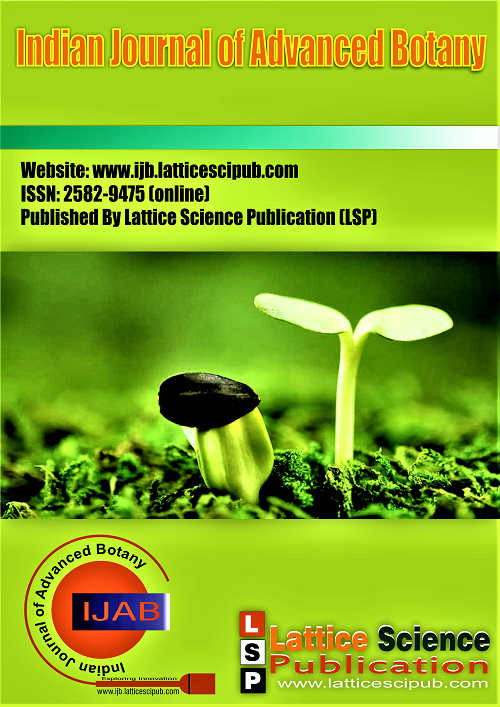Invasive Plant Species in Mangrove Wetlands: Patterns of Spread and Ecological Threats
Main Article Content
Abstract
Biological invasions pose a serious threat to natural ecosystems. Mangroves are vulnerable to invasion by salt-tolerant aquatic and terrestrial plants, such as epiphytes, despite their extremely saline and intertidal habitat. The present study examines the invasion rates and assesses the ecological impacts of invasive plant species on the mangrove flora of Kannur District, Kerala. Extensive field visits were conducted in the selected study stations to analyse plant species using the line transect method. A total of 21 plant species, including 7 true mangroves and eight mangrove associates, were recorded from the study areas. Out of the identified plant species, 11 are invasive, belonging to 5 families and 11 genera. The highest invasion rate was observed in Ipomoea cairica (1.203) at site-2, followed by Volkameria inermis (4.404×10-1 ). The competition between invasive plants and native species for light, nutrients, and space impacts the growth, development, and diversity of mangroves. Well-framed policies and effective management strategies are vital to curb invasive plant spread and safeguard the long-term conservation of mangrove ecosystems.
Downloads
Article Details

This work is licensed under a Creative Commons Attribution-NonCommercial-NoDerivatives 4.0 International License.
How to Cite
References
Turbelin, A., & Catford, J. A. (2021). Invasive plants and climate change. In Climate change (pp. 515-539). Elsevier.
DOI: https://doi.org/10.1016/B978-0-12-821575-3.00025-6
Wang, Z., Yue, R., & Li, Y. (2021). Research Progress on Growth Characteristics of Invasive Plants in Different Habitats. In E3S Web of Conferences (Vol. 257, p. 03023). EDP Sciences. DOI: https://doi.org/10.1051/e3sconf/202125703023
Lipińska, H., Lipiński, W., Shuvar, I., Korpita, H., & Shuvar, A. (2023). Invasive plant species and their threat to biodiversity. Plant & Soil Science, 14(1). DOI: https://doi.org/10.31548/plant1.2023.51
Li, Y., Yue, M., Wang, Y., Mao, Z., Lyv, J., & Li, Q. (2024). Invasive‐plant traits, native‐plant traits, and their divergences as invasion factors. Ecology and Evolution, 14(6), e11525. DOI: https://doi.org/10.1002/ece3.11525
Chen, Y., Xie, Y., Wei, C., Liu, S., Liang, X., Zhang, J., & Li, R. (2024). Invasive plant species demonstrate enhanced resource acquisition traits relative to native non-dominant species but not compared with native dominant species. Diversity, 16(6), 317.
DOI: https://doi.org/10.3390/d16060317
Barrera, J. C. C., Lancho, J. F. G., Puschendorf, R., & Hernández, C. M. A. (2025). Loss and Early Recovery of Biomass and Soil Organic Carbon in Restored Mangroves After Paspalum vaginatum Invasion in West Africa. Resources, 14(8), 1-19.
DOI: https://doi.org/10.3390/resources14080122
Bezabih Beyene, B., Li, J., Yuan, J., Dong, Y., Liu, D., Chen, Z., ... & Ding, W. (2022). Non‐native plant invasion can accelerate global climate change by increasing wetland methane and terrestrial nitrous oxide emissions. Global Change Biology, 28(18), 5453-5468.
DOI: https://doi.org/10.1111/gcb.16290
Biswas, S. R., Biswas, P. L., Limon, S. H., Yan, E. R., Xu, M. S., & Khan, M. S. I. (2018). Plant invasion in mangrove forests worldwide. Forest Ecology and Management, 429, 480-492. DOI: https://doi.org/10.1016/j.foreco.2018.07.046
Hovick, S. M., Adams, C. R., Anderson, N. O., & Kettenring, K. M. (2023). Progress on mechanisms and impacts of wetland plant invasions: a twenty-year retrospective analysis and priorities for the next twenty. Critical Reviews in Plant Sciences, 42(4), 239-282.
DOI: https://doi.org/10.1080/07352689.2023.2233232
https://www.indianbiodiversity.org/
http://www.keralaplants.in/search-flowering-plants-of-kerala.aspx
Biswas, S. R., Choudhury, J. K., Nishat, A., & Rahman, M. M. (2007). Do invasive plants threaten the Sundarbans mangrove forest of Bangladesh? Forest Ecology and Management, 245(1-3), 1-9.





